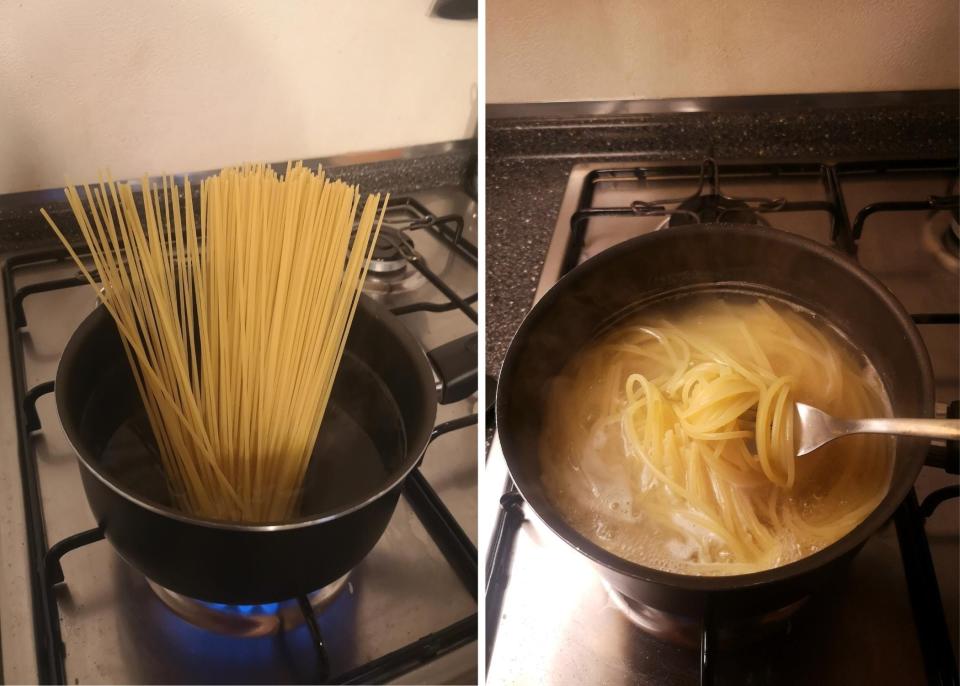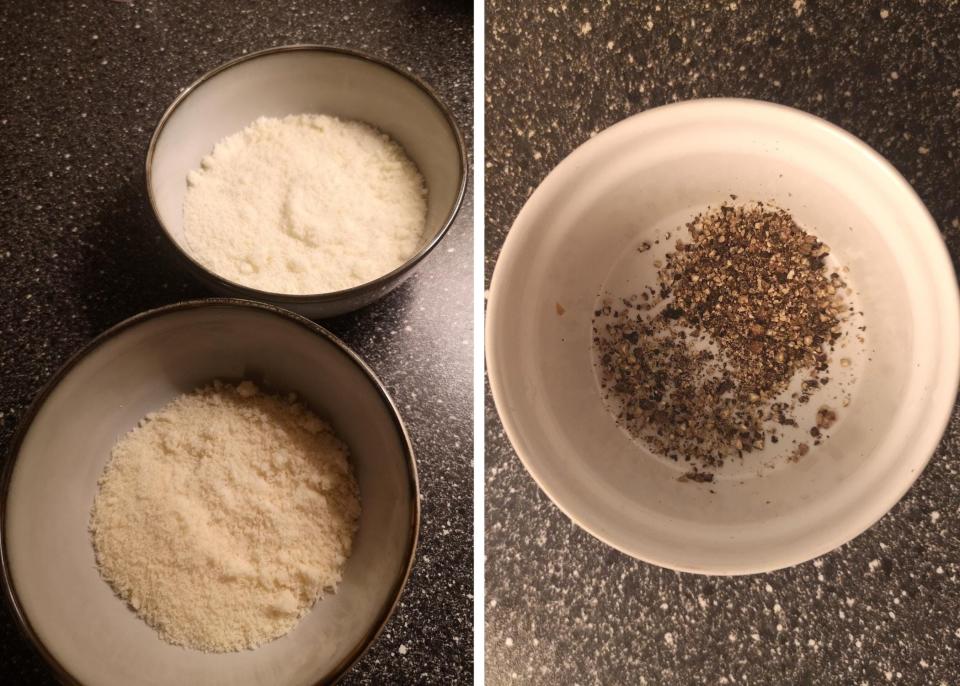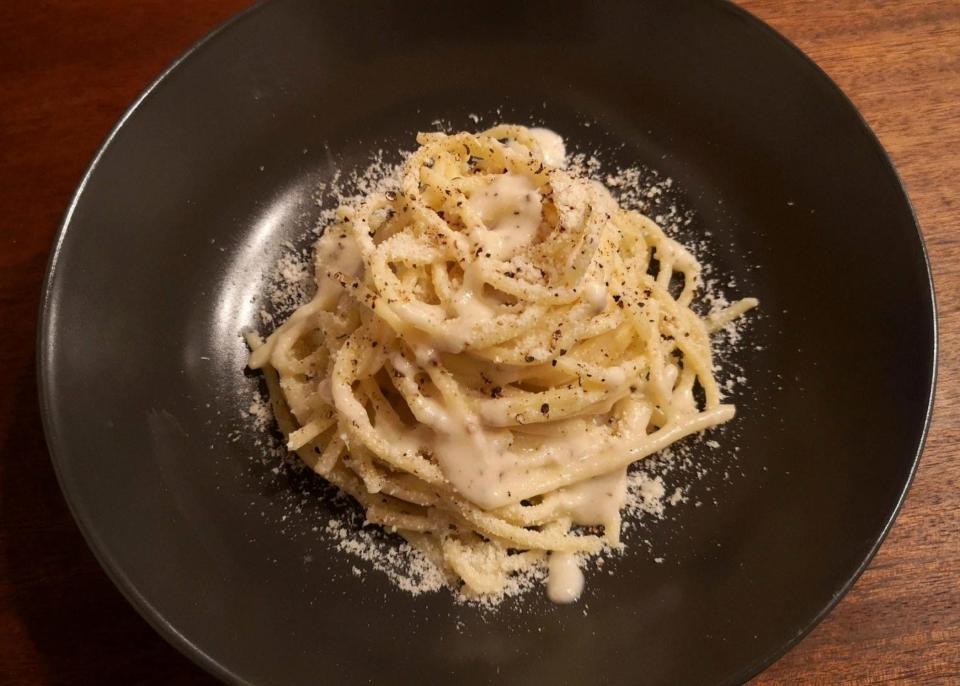I made cacio e pepe from Stanley Tucci's 'Searching for Italy,' and while the recipe breaks tradition it's still heaven in a bowl

I made cacio e pepe, a cheese and pepper spaghetti, from Stanley Tucci's show "Searching for Italy."
The Roman classic is one of four dishes the city is known for but this recipe breaks the tradition.
Romans only use Pecorino Romano for the dish but chef Kotaro Noda adds Parmigiano Reggiano.
I watched Stanley Tucci's travel cooking show, "Searching for Italy," before visiting Rome and one of the four Roman pastas caught my attention — cacio e pepe.

Just weeks after binge-watching Stanley Tucci's Emmy award-winning show, "Searching for Italy," which premiered in the UK in late February, I visited Rome, Italy's capital city. As I saw in episode 2 of Tucci's show, centered on Rome, locals are known for four key pasta dishes that the 61-year-old actor tries.
Tucci's first stop is restaurant Armando al Pantheon, where he eats amatriciana, made with rigatoni in a tomato sauce, guanciale (pork cheek), and grated Pecorino Romano cheese.
While dining at Trattoria Pommidoro, in the San Lorenzo neighborhood, Tucci hears about alla grecia, made with guanciale, Pecorino, and black pepper. He eats the more commonly-known dish, carbonara, a spaghetti that requires raw egg yolks, grated Pecorino, and crispy pork belly.
As someone who doesn't eat pork, it was the fourth and final dish that caught my eye for its simplicity and creamy appearance, Cacio e pepe, made with Pecorino and black pepper.
I tried cacio e pepe in Rome a number of times in Rome but I'd never tried a different take on the three-ingredient recipe.

Cacio e pepe is spaghetti that traditionally uses just grated Pecorino and ground black pepper, but chef Kotaro Noda tells Tucci in the show he has a secret recipe that uses a mix of Pecorino and Parmigiano, which he serves in his Michelin-starred restaurant, Bistrot64.
During my time in Rome, the meat-free pasta dish became my go-to choice and it was consistently good when made with just Pecorino, so I became curious to see what happens to the flavor palette when another cheese entered the mix.
The simple recipe requires just four ingredients, or three if you prefer the traditional Roman recipe.

Traditional versions of the dish only use Pecorino Romana, but as chef Kotaro Noda swears by the addition of Parmigiano Reggiano in a 70:30 cheese ratio, I wanted to give the recipe a go. As I had tried traditional cacio e pepe in Rome, I had a great point of comparison.
While the show highlights Noda's ingredients, it doesn't offer a step-by-step recipe. After some trial and error, I found the measurements that worked for me. To make two servings of cacio e pepe, according to Noda's technique in the show, you'll need:
300 grams spaghetti (or bucatini, which will take longer to cook until al dente)
70 grams of Pecorino Romana (grated)
30 grams Parmigiano Regiano (grated)
A teaspoon of ground black pepper.
Start by heating a pan of water until it's boiling and then add 300 grams of spaghetti and cook until al dente.

Boil a pan of water that is three-quarters full and add a teaspoon of salt. Once it's boiling, add 300 grams of spaghetti and cook for around seven minutes, stirring to ensure the spaghetti doesn't stick to the pan's base.
Once the pasta is al dente, drain it while reserving one cup of pasta water as this will become part of your sauce later.
Weigh 70 grams of Pecorino Romana and 30 grams of Parmigiano Reggiano in a bowl and grind some black peppercorns.

After weighing the cheeses, I mixed them together in a bowl and stirred. The unique cheese mix used by Noda in the episode breaks the traditional Roman recipe I enjoyed on about five occasions during my time in the eternal city.
Noda is a Japanese chef who moved to Italy 20 years ago after being seduced by the flavors of the Mediterranean nation, Tucci says in the show. Noda tells the actor: "Italian cuisine has a balance in a dish with very few ingredients."
One of the show's producers, Karen, who is from Rome, describes the dish as "divine," though Noda says while Italians come to his restaurant, Romans have stopped. Tucci says that Rome's commitment to traditional cuisine may be the reason they resist Noda's creative food but they're missing out.
Place the pasta in a mixing bowl and slowly add the cheese mix with spoonfuls of pasta water until the spaghetti is coated. Alternate adding the pepper and cheese.

I slowly started to add the cheese mix to the bowl with spoonfuls of pasta water that I reserved earlier. The trick is to keep shaking the bowl and keep the pasta moving. In the episode, Noda touches on why this technique is necessary, saying: "We need to cool it down a bit, that way it becomes creamy."
Between adding spoonfuls of cheese and water, I added a light sprinkle of the teaspoon of pepper that I had ground. I repeated these steps until I ran out of cheese and pepper.
The simple meal takes no longer than 15 minutes to make, but its taste lies in your ability to be patient when adding cheese and pasta water.

It can be tempting to fling the ingredients in after a while but taking time means that cheese clumps don't form, allowing the spaghetti to be evenly coated in the creamy sauce.
As Tucci says, cacio e pepe seems "ludicrously simple" but as I learned the first few times I tried to make it, a lot can go wrong. It took three times for me to learn the motions and techniques needed to feel confident that I wouldn't deeply offend Romans with my attempts at this classic dish.
Add any additional pepper depending on your personal taste and top with more Pecorino before serving.

I span the pasta into a nest shape with a deep ladle and a fork. Once plated up, I added more Pecorino and pepper on top to enhance its presentation. The meal didn't take very long to make but, as you can tell from the way I was looking at the dish, I was already drooling over it.
This cacio e pepe recipe might break Roman traditions but the vegetarian dish will be my go-to quick lunch for years to come.

Having tried cacio e pepe a number of times during my Rome trip, I enjoyed it and found that most recipes tasted very similar regardless of whether I ate at a trattoria or a ristorante.
This cacio e pepe recipe might break tradition but the second cheese added a new depth of flavor that enhanced the dish. The sharpness of the pepper with the strength of the cheeses is a perfect flavor match and, because it takes no time at all, it's become my new favorite meal to have at lunchtime.
I almost always keep spaghetti and pepper at home so whenever I feel like having the simple dish, all I need to do is buy the cheeses. As the Romans proved during my time there, sometimes less really is more.
Read the original article on Insider

 money
money 